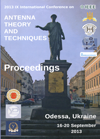Electrodynamic analysis of disk nanoarrays
DOI:
https://doi.org/10.1109/ICATT.2013.6650739Keywords:
disk nanoarrays, optic range, complex dielectric permittivity, approximate boundary conditions method, integral equations, Galerkin method, resonanceAbstract
Boundary problem of diffraction electromagnetic waves on two-dimensional periodic metal gratings have been solved with taking into account finite permittivity of metal in optic range. Suggested technique is based on approach of approximate boundary conditions for thin dielectric layers. It is pointed out that dependence of magnitude of scattered field on wavelength has resonant behavior and resonant wavelength is many times higher than size of cell of grating. It is shown the possibility of designing of grating with high reflection coefficient at frequencies of plasmon resonance.References
MITTRA, R.; CHAN, C.H.; CWIK, T. Techniques for analyzing frequency selective surface - A review. Proc. IEEE, 1988, v.76, n.12, p.1593-1615, doi: http://dx.doi.org/10.1109/5.16352.
KASYANOV, A.O.; OBUKHOVETS, V.A. Frequency selective surface. The main field of application. Antennas, 2005, v.9, p.4-12.
WEINSTEIN, L.A. The Theory of Diffraction and the Factorization Method. Moscow: Radio, 1966 [in Russian].
ZELENCHUK, D.E.; KAZMIN, I.A.; LERER, A.M.; ET AL. Application of impedance boundary conditions for solving the problem of electromagnetic wave diffraction optical range on metal nanostructure arrays. Radio Engineering and Electronics, 2009, v.54, n.4, p.418.
Published
2014-02-19
Issue
Section
AA, AAA, smart antennas and signal processing

